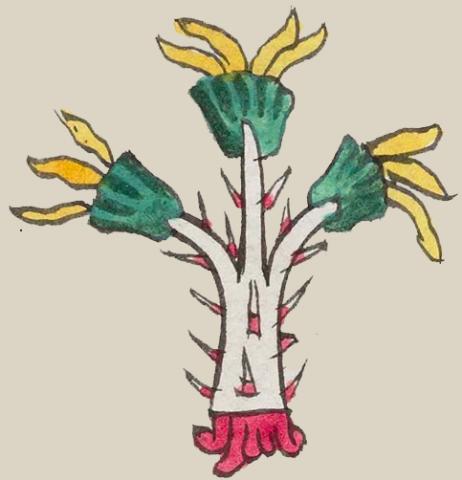huixachin (Mdz17v)
This element of a huixachin tree or bush (or the adjective "very thorny") has been carved from the glyph for the place name, Huixachtitlan. The huixachin is a tree with a white or neutral-colored trunk, very spiny, with a leader and two branches that have green foliage and what appear to be long yellow pods. The roots of the tree, colored red here, are intentionally made visible.
Stephanie Wood
The presence of so many and such notable spines supports the reading that the Nahuatl root is huitztli (spine, thorn, spike), in combination with achin, "a lot of, many." Gordon Whittaker (Deciphering Aztec Hieroglyphs, 2021, 99) suggests this interpretation. These spines also show a slight red color at their base, which could be representative (botanically) or could point to the use of these spines for blood letting. The flint knife (tecpatl), used for sacrifice, is red and white. The thorn (huitztli), used for self-blood-letting, has red tips. The leaves of the huixachin had a role in the Aztec recipe for black ink. [See: Manuel Orozco y Berra, La civilización azteca (1988), 125.] Follow this link to see a photo of a "huizache" tree, with its yellow flowers and seed pods.
Stephanie Wood
c. 1541, but by 1553 at the latest
Stephanie Wood
trees, bushes, spines, spiny, thorns, Huitzaxin, Huitzachin, Huitzache, espinas, árboles, espinosas

huixach(in), a spiny tree or bush in the acacia or mimosa family, or the adjective, very thorny, https://nahuatl.wired-humanities.org/content/huixachin
huitz(tli), thorn, spine, spike, https://nahuatl.wired-humanities.org/content/huitztli
la mimosa or la acacia (árbol o arbusto)
Stephanie Wood
Codex Mendoza, folio 17 verso, https://digital.bodleian.ox.ac.uk/objects/2fea788e-2aa2-4f08-b6d9-648c00..., image 45 of 188.
The Bodleian Libraries, University of Oxford, hold the original manuscript, the MS. Arch. Selden. A. 1. This image is published here under the UK Creative Commons, “Attribution-NonCommercial-ShareAlike 3.0 License” (CC-BY-NC-SA 3.0).




